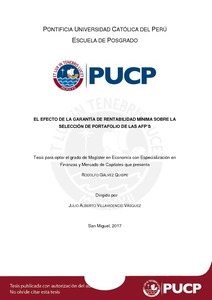| dc.contributor.advisor | Villavicencio Vásquez, Julio Alberto | |
| dc.contributor.author | Gálvez Quispe, Rodolfo | es_ES |
| dc.date.accessioned | 2017-02-14T14:42:50Z | es_ES |
| dc.date.available | 2017-02-14T14:42:50Z | es_ES |
| dc.date.created | 2016 | es_ES |
| dc.date.issued | 2017-02-14 | es_ES |
| dc.identifier.uri | http://hdl.handle.net/20.500.12404/7764 | |
| dc.description.abstract | El documento explorará como una parte de la regulación, la Garantía de
Rentabilidad Mínima (GRM), penaliza la diferenciación de portafolio, influye sobre
la distribución de activos e induce efectos manada en este. La incompatibilidad de
incentivos generada por la GRM estaría provocando que los Administradores de
Fondo de Pensiones (AFP’s) lleven a cabo una selección de portafolio ineficiente
desde el enfoque clásico Media-Varianza. Los afiliados esperarían que las AFP’s
maximicen el retorno y minimicen el riesgo; sin embargo, el costo de la GRM
estaría provocando, que además de estos dos objetivos, las AFP’s estén
maximizando la correlación entre su portafolio y el portafolio benchmark. Primero,
conforme a Pennacchi (1999), se valuará el costo de la GRM como una opción
put exótica; luego, dada la función del costo obtenida, se buscará la asignación
de portafolio óptimo más adecuada, tomándose el enfoque Media-Varianza-
Covarianza de Wagner (2001); y por último, conforme a esta asignación, se
determinará las fronteras eficientes para las AFP’s en el Perú. | es_ES |
| dc.description.abstract | This paper will explore how a part of the Peruvian regulation, the Minimum Return Guarantee (MRG), will cause the Pension Fund Administrators (PFA’s) to minimize variance and maximize covariance, affecting their portfolio selection process. The incentive incompatibility caused by the MRG could be inducing the Portfolio Managers to carry out an inefficient portfolio selection. The PFA’s would be expected to maximize return and minimize risk; however, in addition to these two objectives, the MRG could be causing the PFA’s to maximize the correlation between their portfolio and the portfolio benchmark. First, the MRG will be valued as an exotic put option; then, given the cost function, the most adequate portfolio allocation problem will be presented; finally, according to Wagner (2001), the efficient frontiers will be derived and the consequences affecting the optimum outcome will be analyzed. | en_EN |
| dc.language.iso | spa | es_ES |
| dc.publisher | Pontificia Universidad Católica del Perú | es_ES |
| dc.rights | Atribución-NoComercial-SinDerivadas 2.5 Perú | * |
| dc.rights | info:eu-repo/semantics/openAccess | es_ES |
| dc.rights.uri | http://creativecommons.org/licenses/by-nc-nd/2.5/pe/ | * |
| dc.subject | Sistema privado de pensiones--Perú--Inversiones | es_ES |
| dc.subject | Inversiones--Administración | es_ES |
| dc.subject | Inversiones--Rentabilidad | es_ES |
| dc.subject | Inversiones--Selección | es_ES |
| dc.title | El efecto de la garantía de rentabilidad mínima sobre la selección de portafolio de las AFP's | es_ES |
| dc.type | info:eu-repo/semantics/masterThesis | es_ES |
| thesis.degree.name | Magíster en Economía | es_ES |
| thesis.degree.level | Maestría | es_ES |
| thesis.degree.grantor | Pontificia Universidad Católica del Perú. Escuela de Posgrado | es_ES |
| thesis.degree.discipline | Economía | es_ES |
| renati.discipline | 311317 | es_ES |
| renati.level | https://purl.org/pe-repo/renati/level#maestro | es_ES |
| renati.type | http://purl.org/pe-repo/renati/type#tesis | es_ES |
| dc.publisher.country | PE | es_ES |
| dc.subject.ocde | https://purl.org/pe-repo/ocde/ford#5.02.01 | es_ES |






